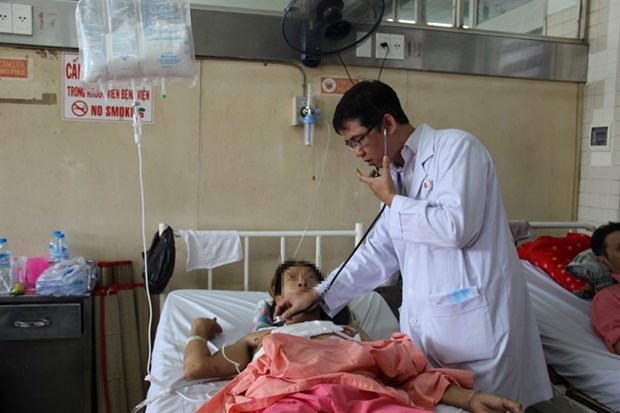 A patient whose life was saved with emergency surgical intervention at Cho Ray Hospital. (Photo courtesy of Cho Ray Hospital)
A patient whose life was saved with emergency surgical intervention at Cho Ray Hospital. (Photo courtesy of Cho Ray Hospital)HCM
City (VNA/ANN) – A 70-year-old was
admitted to Cho Ray Hospital in HCM City on Lunar New Year’s Eve with a sudden
onset of severe chest pain.
Mikochi
had and passed out just as his flight was arriving at Tan Son Nhat
Airport.
He was
sent to an international clinic for immediate resuscitative efforts and
transferred to Cho Ray Hospital’s emergency department due to his critical
condition.
He was
diagnosed with Stanford type A acute aortic dissection, which requires early
treatment for survival, Nguyen Thai An, head of the cardiac surgery department,
said.
Trauma red alert,
the highest level, was activated and an operating room was readied within 60
minutes, he said.
Administrative
procedures were skipped to carry out the life-saving surgery immediately, he
said.
All
the members of the hospital’s rapid response team were present in the surgery
room though it was New Year’s Eve.
In the
event, the surgical intervention saved the patient’s life. He was discharged
six days later in stable condition.
Truong
The Hiep, deputy head of the hospital’s emergency department, said it receives
an average of 350 patients every day, most of them with multiple injuries.
A
third of them need emergency surgical intervention, he said.
In
some cases doctors have to provide cardio-pulmonary resuscitation and perform
surgery at the emergency department’s surgery room since any delay could be
fatal, he said.
The
hospital’s rapid response system helps save dozens of critically ill patients
every year.
Since
paediatrics trauma alert red was initiated in 2008, doctors at the HCM City
Paediatrics No.1 Hospital have performed around 20 emergency surgeries required
upon its activation.
Inter-hospital
alert
Last
September Nguyen Thi Hieu Thao, 20, of Hoc Mon District suddenly developed
severe eclampsia when she was nine months pregnant and was admitted to Thong
Nhat Hospital for emergency attention.
She
was in a coma, her blood pressure was a high 210/120 mm Hg. She later went into
cardiac and respiratory arrest.
Doctors
provided cardio-pulmonary resuscitation and called Hung Vuong Obstetrics and
Gynaecology Hospital’s emergency response team for immediate surgical
intervention.
Hung
Vuong’s rapid response team of obstetricians, medical assistants and nurses
performed a caesarean section to deliver the baby within 20 minutes of the
activation of the alert.
Thao
and her 3.4kg boy soon became stable and were discharged a one week later.
Nguyen
Thi Le, Thao’s mother, said, overwhelmed: “It was like a miracle. I almost
passed out. I thought my daughter would die.
“The
doctors were so good they could save the life of mother and son.”
“As
soon as we receive an alert call, we have to act rapidly and concentrate
intensely,” Nguyen Thi Anh Phuong, deputy head of Hung Vuong Hospital’s
obstetrics department, said.
“The
goal is to save the patient’s life.”
Phuong
has twice been on the rapid response team to provide emergency out-of-hospital
surgical care.
The
successful operation on Thao was attributed to close co-ordination between
doctors at the two hospitals and the activation of the alert, which circumvents
procedures and facilitates immediate surgery.
It was
one of six out-of-hospital surgeries performed since the city Department
of Health introduced the inter-hospital alert last year.
City-wide
expansion
Tang
Chi Thuong, deputy director of the department, said the inter-hospital alert
for rapid response emergencies is a life-saving measure for critically ill
patients who would otherwise die on the way to hospital.
“Co-ordinated
action by multi-disciplinary physicians and hospitals are crucial to successful
emergency life-saving surgical intervention.”
The
department has recommended implementation of hospital-wide and inter-hospital
alerts across the city to improve survival rates.
Cho Ray
Hospital plans to set up surgery rooms in various departments to simplify
the process for emergency surgeries, Pham The Viet, head of the hospital’s
general planning department, said.
The
number of patients admitted to Cho Ray Hospital with life-threatening
conditions has soared in the past few years, he said.
Last
year there were 15 cases that triggered trauma alert red, and doctors managed
to save 10 of the patients.
In the
first two months of this year there have already been eight, Viet said.
The
activation of hospital-wide alerts should also be standardised with an
integrated set of co-ordinated actions so that it can operate smoothly and
effectively, he added.- VNA
Source: VietnamPlus
